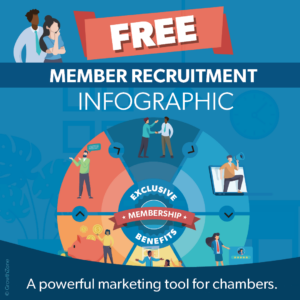by Frank Kenny
What I’ve Discovered Through 12 years of Facilitating Board Retreats & Strategic Planning:
All chambers are sitting on gold mines.
They all have huge potential.
They just do not realize it.
Let me share with you some of the strengths of your chamber and this industry.
- You have a virtual monopoly in your area. There is usually just one chamber in a community or area.
- Chambers have a business model with recurring revenue. Just over the last few years you’ve seen lots of businesses realize what an amazing thing it is to have recurring revenue. Think of Netflix and Adobe.
- People will write your chamber sponsorship checks. People are willing to give your chamber money on the hope that it will come back to them with goodwill. How many small businesses have people writing them sponsorship checks?
- In almost every community in this country there is a Chamber of Commerce, and it is well respected, even loved. It is a brand that is well-established with know, like, and trust.
- Top businesspeople in the community are willing to contribute their time and expertise to guide the chamber.
So, your chamber is sitting on a gold mine.
How do you find these nuggets and release them?
First, you need to ditch the poverty and charity mindset. You need a culture of abundance. You need to believe in your potential. Then you must take bold risks and be willing to innovate.
Simply put, you have to run the chamber as a small business. You have to entrepreneurial. Offer a return on investment rather than asking for a donation. Solve business-related problems for your members.
How do you make this pivot?
The best way is through strategic planning.
Strategic Planning
The process requires your board to be brutally honest about where your chamber is now, where the board wants it to be, and then to figure out a path to get there.
I’m going to share with you my strategic planning framework for chambers. Use it as your own to tap into your gold mine.
The first step in the strategic planning framework is a board orientation. Board members need training on how to oversee a healthy chamber and be a healthy chamber board of directors. They need training on the chamber business model. They need to know what numbers are important and how to measure them. The board orientation takes about an hour and a half.
Next you need a visioning session. It provides a chance for every board member to share their long-term vision for the organization. Big thinking three, five, ten years out.
What would they like the chamber to really focus on? What would they like to see the chamber doing? Not the mundane day to day things but big ideas.
What this does is create momentum and belief among the board members of thinking bigger, reaching for bigger things. They start piggybacking on each other’s ideas.
 By the end of the visioning session there’s much more excitement.
By the end of the visioning session there’s much more excitement.
There’s a much larger vision for the chamber, of what’s possible.
Then do a SWOT analysis.
Board members need to know the reality, the true situation, of the organization. What are the chamber’s strengths, what are the weaknesses? You need to play to your chamber’s unique strengths and shore up weaknesses.
What are the opportunities the chamber could tack take advantage of? What threats does the chamber face? Let’s get them written down. A lot of the opportunities come out of the board orientation and the visioning session
Then, using the SWOT analysis, decide on your chamber’s strategic objectives over the next 3 years. You want a limited number of strategic objectives or goals. 3, 5, maybe 7 major goals or strategic objectives of where the board wants to take the chamber.
Areas That Have Big Up-sides for Chambers:
Tiered Dues. If you’re still on the fair share business model dues model where everybody gets exactly the same thing, but some people pay more because they have more employees, you need to update your model. Move to tiered dues where the investment is based upon the deliverables members they want and need from the chamber. You’ll find that not only is it easier to sell, it increases retention and brings in more dues and non-dues revenue. It allows for ascending members from level to level.
Marketing and Sales. Chambers need to spend money to make money. How much is your chamber investing on marketing and sales? What’s your cost of acquiring a new member? If your chamber doesn’t have any clue what it costs to acquire a new member, that’s a problem.
Hire and retain talent. I find that a lot of Chambers they have money in the bank, they have reserves, they have pretty good income, but they won’t use it to pay their staff well, with benefits, so they find that as soon as somebody prove themselves that businessperson gets stolen away. Be an employer of choice in your community attract and retain talent.
Board members. Only have top people on your board of directors. People who are getting big things done for their business or the community. Have the CEO from the hospital on the board, the CEO from the local bank, the CEOs from the top manufacturers and retailers. Every seat should be held by a top decision-maker in the community.
Solve community problems. Chambers should be working on solving community problems, not just member problems. Yes, it’s important that the members get value for their membership, that they get what they’re investing in, but the chambers that are very healthy are doing bigger things beyond just what’s in it for the members. Work on affordable housing, workforce development, safe streets. Chambers, as the organized business community, are bringing solutions to these and other problems.
Voice of Business. Your chamber must be the voice of business in your community. A lot of Chambers choose not to get involved in politics and I completely understand that, but you can still be the voice of business in your community, without being partisan, without taking sides on partisan issues. Study the business-related issues through your government affairs committee. Important issues get kicked up to the full board for a vote. Then the chamber takes a position, a stand, for the good of the business community. The business Community needs somebody to be their voice, to have their back. That is a core role of a local Chamber of Commerce.
All of this is at your chamber’s fingertips if you believe it is. If you are bold. If you think of your chamber as a successful small business.
Just think what your chamber could be doing for your members and community if you strike it rich with your gold mine!
As a gift, download my Strategic Planning Framework for Chambers of Commerce.
Frank Kenny is an internationally recognized author, professional speaker, and consultant. He is the founder of the Chamber Focus Show and the Chamber Professionals Community Group on Facebook.
Over the past 10 years, Frank has helped hundreds of chambers reach their goals with staff and member training, strategic planning, board retreats and orientations, social media, digital marketing, technology, and more.

